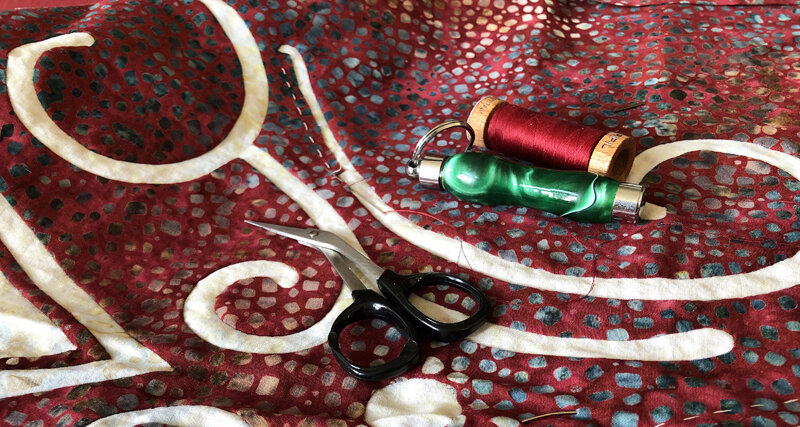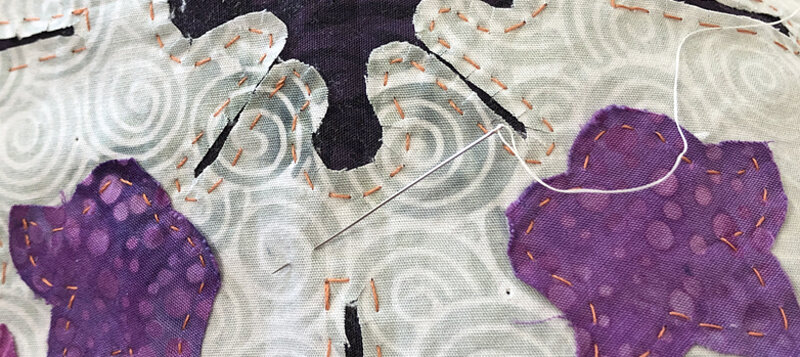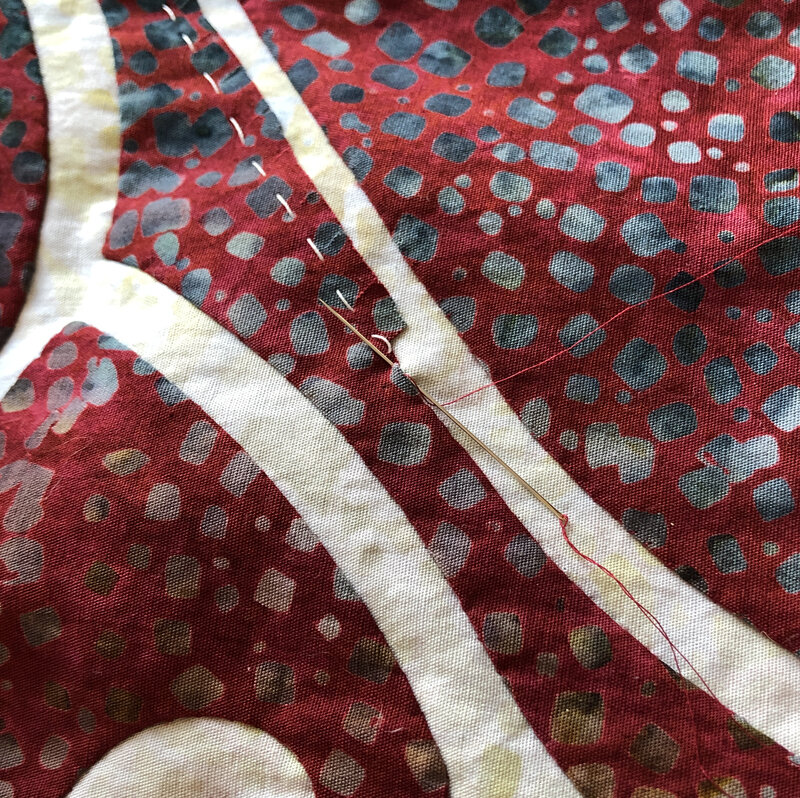Hand Sewing Needles: When to Replace Them
Hand reverse applique underway of Vintage Jewel table runner using No. 11 Milliner’s needle.
When it comes to our sewing machines we quilters have learned that we need to change the needle. The sewing machine companies have taught us to change the needle when we start a new project, when we hear a “thud” or clunk” as we sew., and, obviously, when the needle breaks.
But have you ever thought about when to change your hand sewing needles and why?
Like a sewing machine needle, a hand sewing needle gets dull, blunted, and worn from use over time. It doesn’t make a “thud” or “clunk” sound, though, letting you know it’s time to change. It’s cues, though more subtle, are important to heed.
Eternal Spring table runner in process of being reverse appliqued.
I adore hand stitching, and have made my specialty hand reverse applique and applique. I typically stitch 2 - 6 happy hours a day and also hand quilt. Though I stitch for business, it is a joy that brings me peace and pleasure. Having good quality, sharp needles makes all the difference to my stitching pleasure.
Using good quality needles can make all the difference. They are sharp, honed well, with no burrs, and tend to bend rather than break.
I create my quilt patterns with our trace, baste, snip & stitch method which primarily uses two hand sewing needles, a No. 7 Sharps needle for the basting phase and a No. 11 Milliner’s needle for the applique/ reverse applique phase. My preferred needle brand is John James.
Like sewing by machine, you should treat yourself to a fresh, new needle at the start of every new project and change your needle every 8 – 24 hours depending on the fibers you are sewing through.
New project = new needle. My No. 11 Milliner’s needle is threaded and ready to begin reverse applique of the white/ gray fabric.
A sharp needle will pierce your fabric(s) and easily glide through them. Your applique/ reverse applique will be more accurate, and your stitches can be smaller, more invisible and consistent.
Applique hand basted accurately in place because my No. 7 Sharps needle was sharp.
Applique accurately hand stitched in place because my No. 11 Milliner’s needle was sharp. I could get my stitches small and invisible, too.
While hand stitching this 52” x 52” quilt I needed to replace my needles quite frequently.
You should change your needle whenever it becomes bent, dull or develops a burr. As a needle is used it becomes dull or can develop a burr (although my John James needles have never developed a burr). As you pull a dull/ well-used needle through, it will drag. You will find that you are pushing the needle through the fabric and the fabric itself will pull. This can cause distortion in what you are sewing. Also, you will feel the resistance, which, over time, can cause hand and wrist strain, cramping and fatigue. Ultimately it could lead to carpal tunnel syndrome.
The John James Gold n’ Glide needles glided through the batiks like butter on this piece.
Damaged or worn needles also result in broken or shredded threads in your fabric, which weakens your fabric. If you see that the needle is catching or snagging the threads of the fabric when you enter and exit the stitch, it’s time to replace it.
After experimenting with several company’s needles, I happily settled upon the John James needles because of the fine quality of the needle. They are honed well and sharp, no burrs, with smooth, strong shafts. Over the years I have tried other needles, but John James have remained my favorites. The No. 11 Milliner’s needles I use are Gold n’ Glide. A Gold n’ Glide needle is covered with a polymer coating which means they glide more easily through the fabrics which diminishes hand/ wrist strain. This is particularly important since I sew mostly batiks and hand-dyes which are tightly woven fabrics. Yet they are fine and sharp enough for when I’m stitching silk as well, without creating fiber pulls.
Interesting tidbit: did you know that with hand sewing needles the bigger the number the finer the needle? And usually, the bigger the number, the longer the needle.
Over time our hand oils and perspiration begin to coat the needles adding drag, and the polymer coating wears off diminishing its gliding qualities. These would also be reasons to replace your needle.
I keep my needles organized by size/ type in separate needle cases so there’s no confusion as to what size/ type I’m reaching for when I’m stitching. My No. 7 Sharps which I use for basting are in my red needle case, my No. 11 Milliner’s needles which I use for applique/ reverse applique are in my green needle case and my Quilting Betweens are in my purple needle case. I alternate between No. 9 and No. 10’s, but store them in the same needle case as I can tell by their length which size they are.
If you don’t use separate needle cases like I do, I suggest you keep them oragnized by size and type, though. I have some select needle cases on special on my website.
I store my No. 7 Sharps needles in a red needle case.
I store my No. 11 Milliner’s needles in a green needle case.
Vintage Jewel table runner top all hand stitched and ready to be layered and quilted.
Good quality needles, changed frequently, are a small price to pay, I think. We pour so much of ourselves into our hand stitched projects, let alone the money we spend for beautiful materials. The price of good needles is minor in comparison to the benefit. Treat yourself. You are worth it. And don’t hesitate to change your needle as often as needed so that you may stitch in health and pleasure for a lifetime of creative, hand stitching joy.
Quilting is a creative act of hope.
Happy quilting….stitching!









